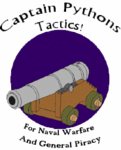 Techniques for More than one Ship:
Techniques for More than one Ship:
Commonly, Pirates worked alone, due to the fact that when alone, all the profits went to that ship. Today, a lot of novels and movies have stories of how two to five Pirate ships in a fleet. In most modern Pirate PC and Video games, you might see a big fleet of two to five ships, every couple of hours! Modern games exaggerate how many Pirates sail the seas to the point that you would think that the Caribbean had a million Pirates. Some games give Pirates 3rd Rate, 2nd Rate, and 1st Rate ships! The biggest pirate ships were only around 40 guns, and commonly never bigger, due to the fact that it was extremely hard to keep the crew numbers up to man such a big vessels, and to feed so many men.
Anyways, sometimes pirates would unite together to help defend each other, take bigger amounts of prizes, and sometimes a cruise with multiple ships can make more profits per ship than a ship by itself (but not often). But the one thing is that these alliances are rarely (if never) between the big ships. Usually, the alliances are between small ships that need the profits and protection. There are also other times when very successful pirates like Black Bart and Blackbeard needed ships to hold cargo, and to have faster ships to catch those faster merchants that are faster than the big flagship. But what are some techniques that these fleets used?
The “Distract the Warship” Tactic
Let’s say that there is a fleet. The fleet is of 2 to 10 merchant ships (usually in the middle of those two numbers), and one warship. It might be a Frigate, a Ship of the Line, or the big Man of War. Commonly the governments of Europe, when they do provide escort ships, it is usually just one ship. During peacetime, the European Navies are small, due to that it costs a lot to keep a big navy out at sea, and all these ships are spread out on their duties. During war, all the ships are out fighting, and they can’t spare ships for escort, unless it is profit to them. Back to the point. Let’s say that you and another ship, both small class ships, want to get one or more of the merchants in that fleet. If you have two ships, there is a way to keep that warship occupied, while you take a prize or two. First thing, advance on the fleet. The head ship will warn the rest of the fleet and run. There are two things that can happen.
Smart Sheppard Situation
After the warning is made, the smart Warship commander would gather the merchant ships together like a Sheppard (the Warship) would gather his flock (the merchants), so he could defend against the wolves (the pirates, or you). The Warship can now protect the fleet better, and having all the merchants together means that they can mass their small amount of fire on you. They probably aren’t the best shots, but combining their fire will probably give them enough lucky hits to cripple a small ship. If the ships are gathered together like this, there is most likely no way that you can get to the merchants.
Stupid Sheppard Situation
This is what you want. While the merchants will scatter, the Warship will try to attack you, as the Warship approaches you and your ally, split up in opposite directions. The Warship can’t attack both of you at the same time, so either the Warship will most likely chase one of you, or attempt to rally the fleet. Even if the Warship attempts to rally the fleet, it will be harder now because they are scattered. While they try to rally, you can probably take one or two prizes. And if the Warship doesn’t rally the fleet, and just chases you or your ally, then the one who is not being chased, can attempt to take prizes. Your small ships can most likely out maneuver the Warship and it’s guns, and out run it. If the Warship chases either you or your ally far enough away from the fleet that the Warship thinks it is safe to go after the other, then that one that has been chased can go and take prizes. This process can be done until the Warship sinks one of you, the Warship rallies the fleet, or you run out of men to take ships and put prize crews on them.
The “Big Small” Tactic
For this tactic, there is the need of two ships, one big ship, and one small ship. Usually fleets that were commanded by one man, and not an alliance of ships, could do this tactic a lot better. In a one-command fleet, there was usually a big flagship with 20 to 40 guns. Now, with this flagship, there would usually be other ships in the fleet that were smaller, like Sloops. Every captain knew that having a fast ship was a good thing to have. Sloops could be used to take ships that have already surrendered, provide them with prize crews, fight smaller ships, and provide a quick escape. But now, let us say this fleet encounters a merchant.
The fleet may encounter a merchant, and let’s say, after encountering this merchant, the merchant still runs. All you need is two ships for this. First, send the Sloop to persuade the merchant to surrender. If that doesn’t work, the sloop can stall the merchant long enough for the bigger ship of 20 to 40 guns to get within range. Usually, that could convince any merchant smaller than the big ship to surrender, but sometimes a little battle is necessary.
The one thing about fleets of Pirate ships is that, like many predators of nature, they operate much better and easier independently, and only band together when protection is needed. Also, being in fleets of ships scared off merchants very quickly. Also, it is easier to track a fleet of ships than one ship, and it is most likely that any ship in the area will quickly get word of a fleet’s presence in that area and take cover or run. If prizes are taken, then the prize’s profits have to be split it amongst the other ships, meaning less profits for all the ships. For these reasons is why pirates did not commonly band together in fleets.
















 Techniques for More than one Ship:
Techniques for More than one Ship: